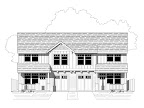Ever notice that a 2x4 isn't really 2"x4"? What's with that? Fact is that the piece of wood started at 2"x4" but is called "rough sawn", that is it has unfinished faces. The stick is then sent through a planer to smooth the faces and reduce serious splinter casualties. About 1/4" is shaved off of each of the four faces resulting in a lesser dimension than you would expect. Besides, who would want to say "one-and-a-half by three-and-a-half"? Mind the twist at 2x8 and beyond...
Now pay attention as we mention dimension convention:
1x:
- 1x2 = .75" x 1.5"
- 1x3 = .75" x 2.5"
- 1x4 = .75" x 3.5"
- 1x6 = .75" x 5.5"
- 1x8 = .75" x 7.5"
- 1x10 = .75" x 9.5"
- 1x12 = .75" x 11.5"
(5/4 material is similar but is 1" thick)
2x:
- 2x2 = 1.5" x 1.5"
- 2x3 = 1.5" x 2.5"
- 2x4 = 1.5" x 3.5"
- 2x6 = 1.5" x 5.5"
- 2x8 = 1.5" x 7.25"
- 2x10 = 1.5" x 9.25"
- 2x12 = 1.5" x 11.25"
- 2x14 = 1.5" x 13.25"
3x: (for those odd structural plates that engineers like to call out)
- 3x4 = 2.5" x 3.5"
- 3x6 = 2.5" x 5.5"
4x:
- 4x4 = 3.5" x 3.5"
- 4x6 = 3.5" x 5.5"
- 4x8 = 3.5" x 7.25"
- 4x10 = 3.5" x 9.25"
- 4x12 = 3.5" x 11.25"
- 4x14 = 3.5" x 13.25"
6x and beyond follows typical pattern as above.
And while we're at it, how about some typical engineered wood sizes.
I-joists are created by standing a piece of OSB or plywood upright and capping it with a 2x flange. The result looks like a capital serif 'I' hence the name.
I-joist flange widths (varies by manufacturer):
I-joist heights (total height):
- 9-1/2"
- 11-7/8"
- 14"
- 16"
- 18"
- 20"
- 22"
- 24"
Laminated Veneer Lumber (LVL) beams are created by gluing several sheets of 7/8" thick plywood together. Installation is by standing them on edge so that the profile looks similar to |||
LVL widths:
- 1-3/4" (2 layers)
- 2-5/8" (3 layers)
- 3-1/2" (4 layers)
- 5-1/4" (6 layers)
- 7" (8 layers)
LVL heights:
- Any height possible though generally intended to match I-joist material. Can match dimensional as well.
Glu-lam beams are created by gluing and compressing several layers of post milled dimensional lumber together. The whole beam is then planed again to create an even surface. For this reason, glu-lam beams are slightly narrower than dimensional lumber. *The industry has recently changed to also offer Gle-lams in full 5-1/2" widths as well. Heights are always in multiples of 1-1/2" due to the size of the plies. *The industry has recently changed to offer heights that are consistent with solid sawn and engineered lumber as well. Due to general engineering practice the height should always exceed the width though rare exceptions always exist.
Glu-lam widths:
- 3-1/8"
- 3-1/2"
- 5-1/8"
- 5-1/2"
- 6-3/4"
- 7-1/4"
- 8-3/4"
- 9-1/4"
- 10-3/4"
Glu-lam heights:
- 6"
- 7.5"
- 9"
- 9.5"
- 10.5"
- 11.875"
- 12"
- 13.5"
- 14"
- 15"
- 16.5"
- 18"
- 19.5"
- 21"
- 22.5"
- 24"
Glu-lams can be used as posts as well. A 3-1/8"x6" glu-lam post is sturdier than a 4"x6".




